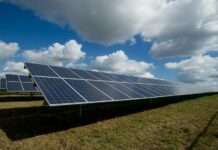Hazelwood is on a 3554 hectare site at Morwell in the Latrobe Valley in Victoria, Australia. It has an associated open cut mine that produces around 18 million tons of brown coal each year. The power station has eight turbine/units, along with switch rooms, coal handling facilities, offices, workshops and stores. It supplies up to 25% of Victoria’s electricity needs โ€“ around 8% of the National Electricity Market. Cooling water comes from the Hazelwood Pondage, which takes its water from the Moondarra Reservoir. The business directly employs around 500 staff, with 300 contractors.
CO2 emissions at Hazelwood
Hazelwood and its associated mine were sold for AUS $2.35bn in 1996 when privatised. Despite equipment investments aimed at reducing dust and other emissions, the plantโ€s emissions intensity is reported to have increased by 2.7% since privatisation. The power station produces up to 17 million tons of CO2 a year, over 5% of Australiaโ€s total emissions.
The World Wildlife Fund has described Hazelwood as Australiaโ€s dirtiest power station and, when considering CO2 emissions per kWh, the most polluting in the industrialised world. Victoria has widely promoted a five-star energy efficient homes standard to save 200,000 tons of greenhouse gases a year, for example, but the whole effort is cancelled out by less than a week of Hazelwood’s operations.
Hazelwoodโ€s owner, International Power Technologies (previously National Power), is now planning to retrofit the station with new technologies. The company has joined a consortium to develop technologies to reduce CO2 emissions from brown coal-fired power stations.
Fluidised bed drying being trialed
Parsons Brinckerhoff prepared the RD&D (research development and demonstration) application to Victoriaโ€s EPA to install and demonstrate fluidised bed drying with internal heat recovery on the stationโ€s Unit 1.
A fluidised bed will dry 50% of brown coal fed to the boiler, reducing its moisture content from 62% to 12%. This will significantly improve burning efficiency and reduce greenhouse emissions. To support the application, Parsons Brinckerhoff assessed noise, greenhouse gas, water, air quality, and flora and fauna, and compiled a description of best practice coal drying technology.
One of three CO2CRC projects
Parsons Brinckerhoff also prepared an application to install a number of carbon capture pilot plants on Unit 8 (including solvent absorption, vacuum swing adsorption and membrane technology). This trial aims to capture CO2 from exhaust emissions and develop end uses for it.
“The aim is to retrofit PCC to existing plants and integrate it into new ones.”
The Hazelwood project is one of three major carbon capture and storage demonstration projects underway at Australiaโ€s CO2CRC (Co-operative Research Centre for Greenhouse Gas Technologies) programme, which aims to demonstrate geosequestration or CCS (carbon capture and storage) will work for Australian power stations. The University of Melbourne is developing solvent and membrane technologies while Monash University is performing R&D on adsorbents.
CO2CRC is testing the technologies in a (25 ton per day) post combustion capture (PCC) unit at Hazelwood. The project aims to determine the effects of operating parameters of CO2 concentration, moisture content, SOx> and NOx> concentration and fly ash properties on the behaviour of sorbent systems and other new separation technologies. It will assess a PCC process and energy integration options for Hazelwood; and review the technical and economic viability. The aim is to retrofit PCC to existing plants and integrate it into new ones. It should be possible to add PCC in stages and operate it independently of the power station.
“The company has joined a consortium to develop technologies to reduce CO2 emissions from brown coal-fired power stations.”
Coal-drying will be trialed this year, while the carbon capture trial is expected to run over the next three to five years. International Power also seeks to use Hazelwoodโ€s by-products, such as kaolin (china clay) processing for the ceramic industry and its mineral ash for soil conditioning.
Mechanical servicing contract
Between 2001 and 2008, all mechanical servicing at the station was carried out by Haden. The company maintains and repairs various plant items on site including the turbo charged 800hp emergency diesel generators, all station and instrument compressed air systems including rotary screw compressors, all ranges of air conditioning units from 2kW to 360kW, and various industrial air dryers and refrigeration systems.

































